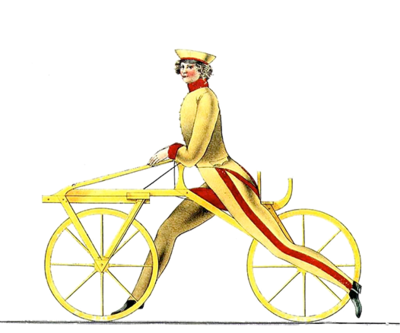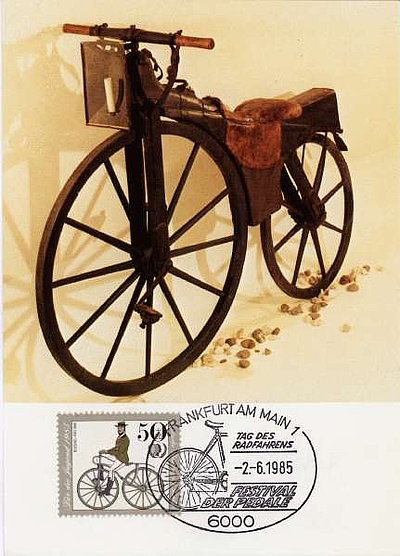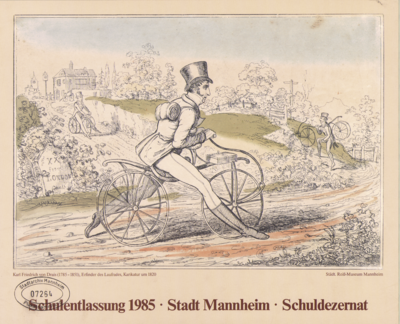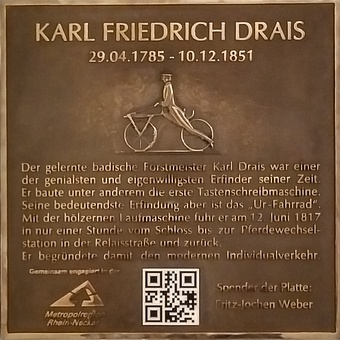
1817 Running machine
Karl Friedrich Baron von Drais (29.04.1785 - 10.12.1851)
Karl Friedrich Freiherr von Drais, a forester by training from Baden, was one of the most ingenious and idiosyncratic inventors of his time. Among other things, he built the first keyboard typewriter. His most important invention, however, was the "original bicycle". On June 12, 1817, he rode the wooden running machine from the castle to the horse-changing station in Relaisstrasse and back in just one hour. He thus founded modern individual transportation.


Karl Drais was born Karl Friedrich Christian Ludwig Freiherr Drais von Sauerbronn in Karlsruhe on April 29, 1785. His father was the chief court judge of Baden, Karl Wilhelm von Drais, and his godfather was none other than Margrave Carl Friedrich von Baden. During his school years, the young Drais does not necessarily meet the expectations of his family. Above all, he was bored with the subject of Latin. Instead, he prefers to work on mathematical and mechanical problems.
After graduating from secondary school, his father sends him to his uncle's forestry school in Schwetzingen. Drais then studied architecture, agriculture and physics in Heidelberg, but then returned to the forestry school for practical training and became a forester. He was soon released from this position and was able to devote himself to his numerous inventions. When the Oberhofgericht was moved to Mannheim in 1810, he moved there with his father.
The list of his inventions is long. Drais not only establishes a formula for solving complicated mathematical equations (1810), but in 1812 constructs a machine that writes down notes while playing the piano on a rotating cylinder. In 1813 he develops a type of calculation in the dual number system and in 1814 a "carriage without horses". His "high-speed typewriter" of 1825 anticipates the later Morse code with its coding. The inventions of the inventive baron even include a new type of "wood-saving stove" (1833) and a "cooking machine" (1834).
The most important invention, however, is a two-wheeled, wooden vehicle driven by the muscle power of its driver: the running machine. On June 12, 1817, Drais used it to travel from Mannheim Castle to the Schwetzingen horse-changing station in today's Relai Street and back in just under an hour. The horse-drawn post takes four hours to cover the same distance!
Despite this impressive demonstration, the people of Mannheim reacted scornfully and dismissively to the running machine. Drais is ridiculed as an eccentric. Later, the running machine is successfully copied all over Europe. Drais himself, however, was unable to derive any economic benefit from his ingenious invention.
He suffers from the fact that, under his father's presidency, the radical fraternity leader Carl Ludwig Sand is sentenced to death for the politically motivated murder of the writer August von Kotzebue in 1820. As a convinced democrat, Drais publicly professed his convictions in 1838 and became a member of the citizen's militia during the Baden Revolution of 1848/1849. He renounced his title of nobility and had to accept social ostracism in return. At the end of his life, he was even threatened with incapacitation. Completely impoverished, Karl Drais died, ill in body and mind, on December 10, 1851 in Karlsruhe, where he was buried quietly and unnoticed.
The value of his estate, including the cooking machine, the oven model, and the high-speed typewriter, is estimated at 30 gulden. Of this, three gulden are allotted to the running machine. But it has a bright future. It evolved into a bicycle and embarked on an unparalleled triumphant march around the globe. With his brainwave, Karl Drais gave mankind one of the most useful inventions in history.
Deutschlandfunk Nova Hörsaal
History of the bicycle: Legs up instead of hitting the brakes
Hans-Jürgen Bartsch, May 7, 2017
Play audio (MP3, 53:16 minutes)
Tour from the bronze plate along the sites of action to Schwetzingen Castle
The bike tour starts in front of the Mannheim Baroque Palace and goes through the sites and monuments to the Schwetzingen Palace.
Waypoints
- Starting point is the bronze plate in honor of the innovator Karl Friedrich Freiherr von Drais, the inventor of the running machine
- Residence in the square M1, 8
- Monument at the Schwetzingen horse changing station in today's Relaistraße
- Schwetzingen castle



